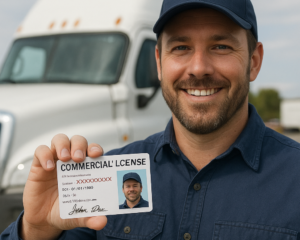Learn about the issues that could impact your commercial vehicle insurance rates.
When purchasing insurance for commercial trucks, insurers consider factors such as experienced employees, well-maintained vehicles, safety, and good credit history. If you have drivers with clean records and follow safety regulations, you may qualify for lower premiums. Additionally, proper truck maintenance, the type of cargo, and business credit also impact rates. Maintaining continuous coverage and avoiding claims can help reduce costs.

What Factors Impact Commercial Vehicle Insurance Rates?
1. Driver History and Safety Record
Two key factors that affect insurance premiums are the experience and driving history of the drivers. Companies with more experienced drivers and a clean driving record can obtain lower premiums, as this indicates that drivers pose a lower risk. Insurers pay close attention to these details, so having novice drivers or those with infractions could result in higher premiums. While this may vary depending on the insurance plan and agency, it is a common trend.
2. Vehicle Type
The model, age, value, size, and usage of a commercial vehicle significantly influence insurance rates. Newer and larger vehicles (such as vans and trucks) tend to be more expensive to insure due to their higher value and repair costs. Additionally, vehicles with higher annual mileage typically have higher premiums, as the risk of accidents increases with more time spent on the road.
Finally, the general condition and maintenance of the vehicle are also factors that insurers evaluate when determining premiums.

3. Routes and Type of Cargo
The specifics of how your business operates, whether as a company or an owner-operator, are important for your insurance agency. What does this mean? A company that uses vehicles for riskier purposes (such as transporting people or hazardous waste) is likely to have higher insurance premiums than one that transports agricultural products, as the exposure to risk is greater.
Another relevant factor is the type of routes driven. If the company only operates within the state, premiums will be lower compared to those that involve interstate travel due to the higher risks associated with long-distance trips.
4. Financial and Credit Status of the Company
A financially stable company projects a good image. Owner-operators, truckers, and transportation companies with poor credit are often seen as more likely to file claims, which can result in higher insurance premiums. Maintaining a good business credit score, on the other hand, may lower insurance rates. Poor credit can be viewed as an indicator of greater risk and responsibility, potentially leading to higher premiums.

5. Insurance History and Claims
The history of insurance and past claims also impact premiums. Insurers view a lack of coverage history or long periods without coverage as a high risk. Similarly, premiums may increase if numerous claims have been made within a short period, as this suggests a higher likelihood of future claims.
6. Type of Coverage
The price of insurance is clearly dependent on the type of coverage. In most states in the U.S., a minimum liability insurance coverage is legally required; however, additional coverages may be necessary, increasing premiums. Additionally, if your vehicle is financed or leased, you are likely to be required to maintain collision and comprehensive coverage.

Always consider these factors carefully when selecting your coverage to ensure you’re getting the best rate possible.

Cannabis reclassification could affect the trucking industry, ATA warns
President Donald Trump signed an executive order directing his administration to reclassify cannabis into a less restrictive federal category, could this affect the trucking industry?

ATA Calls for Tougher Penalties Against Cargo Theft
Cargo theft has moved from being an industry nuisance to a national concern. The American Trucking Associations (ATA) warned Congress that the crime is draining billions from the U.S. supply chain, disrupting logistics operations, endangering drivers, and increasingly intersecting with organized crime and national security threats—prompting renewed calls for stronger federal penalties and coordinated enforcement.

The first Bipartisan Trucking Caucus
Led by a group of lawmakers who come together to pursue shared policy goals, the caucus will focus on the integrity, safety, and growth of

NDAA passed with new protections for truck drivers and military freight
Congress approved the National Defense Authorization Act, a key piece of legislation that includes provisions aimed at protecting truck drivers. Congress approved this week the

California to Reissue Contested Commercial Driver’s Licenses, Challenging Federal Pressure
California plans to reissue contested commercial driver’s licenses (CDLs), reopening a regulatory dispute with federal authorities and raising key questions for the U.S. trucking industry.

Tesla faces suspension in California due to false advertisement
The California DMV announced that sales of Tesla Inc. vehicles could be suspended for 30 days in the state, due to marketing practices that “mislead
